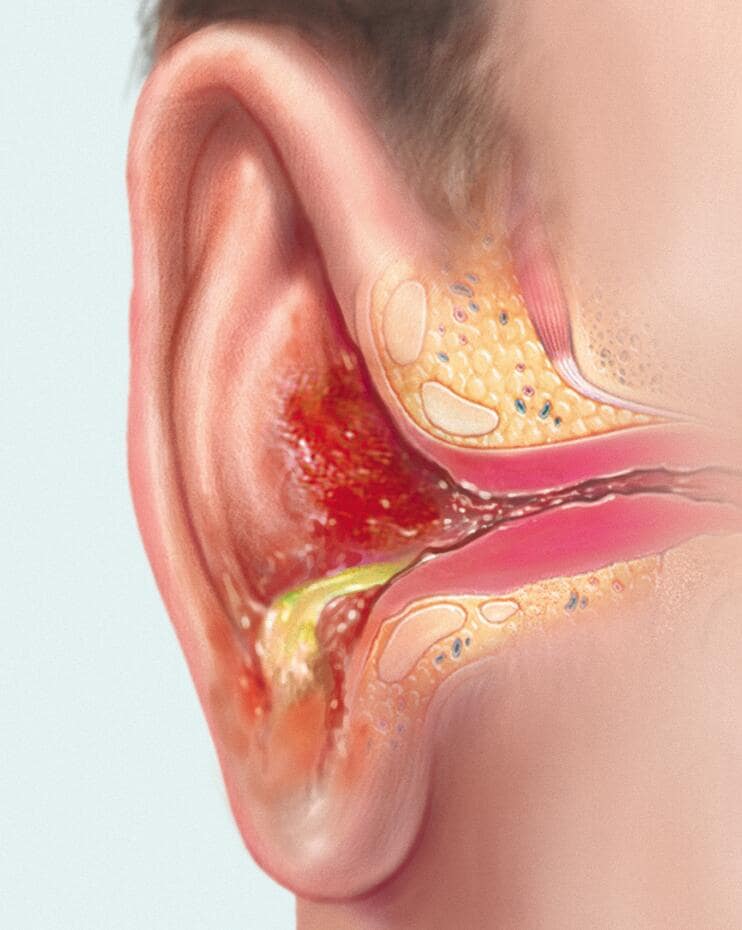Bacterial otitis externa, often referred to as “swimmer’s ear,” is a common ear infection that affects the outer ear canal. It is typically caused by bacterial infections and can result in discomfort, pain, and sometimes serious complications if left untreated. In this article, we explore the causes, symptoms, diagnostic methods, treatment options, and preventive measures.

What is Bacterial Otitis Externa?
Bacterial otitis externa is an inflammation of the external auditory canal, most commonly caused by bacterial pathogens. The condition often arises when water becomes trapped in the ear canal, creating a moist environment conducive to bacterial growth. While it can affect people of all ages, swimmers, divers, and individuals living in humid climates are at a higher risk.
Causes and Risk Factors
The primary cause of bacterial otitis externa is the overgrowth of bacteria in the ear canal. Common bacterial culprits include:
- Pseudomonas aeruginosa
- Staphylococcus aureus
Risk Factors:
- Prolonged exposure to water (swimming, bathing)
- Excessive ear cleaning, causing trauma to the canal
- Use of hearing aids or earplugs
- Skin conditions like eczema or psoriasis
- Narrow ear canals or anatomical abnormalities
Symptoms of Bacterial Otitis Externa
Recognizing the symptoms early can aid in timely treatment. Common symptoms include:
- Ear pain: Often severe and exacerbated by movement of the ear or jaw
- Itching: Persistent itching in the ear canal
- Discharge: Clear, yellow, or pus-like fluid from the ear
- Swelling: Redness and swelling of the ear canal
- Hearing loss: Temporary hearing impairment due to blockage
Diagnosis of Bacterial Otitis Externa
Diagnosis is typically clinical and performed by an otolaryngologist. Key steps include:
- Medical History: Understanding symptoms and risk factors
- Physical Examination: Using an otoscope to inspect the ear canal for redness, swelling, and discharge
- Cultures: Swabbing the discharge to identify specific bacterial pathogens if necessary
Treatment Options
Effective treatment addresses both the infection and the underlying cause.
1. Medications
- Antibiotic Ear Drops: First-line treatment, often containing ciprofloxacin or ofloxacin
- Corticosteroids: Reduce inflammation and swelling
- Analgesics: Over-the-counter pain relievers like ibuprofen or acetaminophen
2. Ear Cleaning
Professional cleaning by a healthcare provider may be required to remove debris and allow medications to penetrate effectively.
3. Home Care Tips
- Keep the ear dry during the treatment period
- Avoid inserting objects into the ear
- Use warm compresses for pain relief
4. Severe Cases
In rare cases, oral antibiotics or hospitalization may be required, particularly if the infection spreads beyond the ear canal.
Prevention Strategies
Preventing bacterial otitis externa involves minimizing risk factors and maintaining ear health.
Key Preventive Measures:
- Dry Ears Thoroughly: Use a towel or tilt your head to remove water after swimming or bathing.
- Avoid Ear Trauma: Refrain from using cotton swabs or sharp objects in the ear.
- Protect Ears in Water: Use earplugs or a swim cap.
- Maintain Hygiene: Clean and dry hearing aids regularly.
Complications
If untreated, bacterial otitis externa can lead to complications such as:
- Chronic Otitis Externa: Persistent or recurring infection
- Cellulitis: Spread of infection to nearby tissues
- Malignant Otitis Externa: Rare but severe infection, often seen in immunocompromised individuals
When to Seek Medical Attention
Consult a healthcare provider if:
- Symptoms persist beyond a few days
- Severe pain or fever develops
- Discharge becomes excessive or foul-smelling
MYHEALTHMAG

